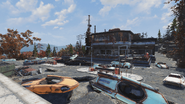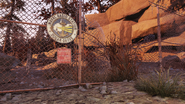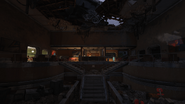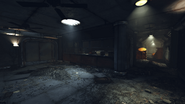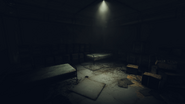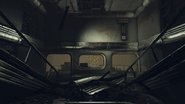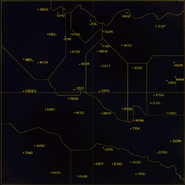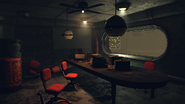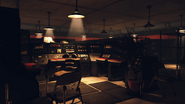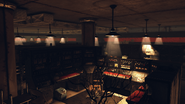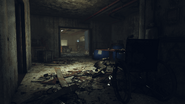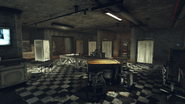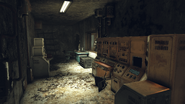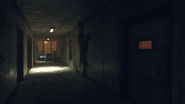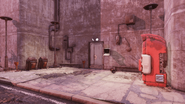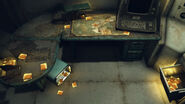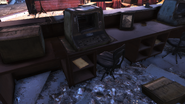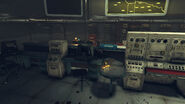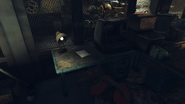Sugar Grove, officially designated Naval Radio Station Sugar Grove, is a location in the Savage Divide region of Appalachia in 2103.
Sugar Grove housed Sugar Grove SigInt, and was billed as simply just another installation supporting the war effort. However, beneath the veneer of legitimacy, the concrete walls of the installation concealed one of the most important intelligence facilities in the United States, a blacksite focusing on homeland security using any means necessary.
Background[]
As a government surveillance facility, Sugar Grove, among other projects, monitored the miners of Appalachia for seditious sentiments (such as calls for unionization and anti-automation, considered "mostly harmless"),[1] complex investigations of money trails for Chinese connections,[2] and as the situation in Appalachia escalated following the increase in automation and the Free States' secession, investigating strikers for communist connections[3] and keeping tabs on the secessionists.[4] All collected intelligence was documented and deposited in the facility's vast archival system.[5] Sugar Grove, however, also played a role in suppressing dissent and opposition, going beyond just watching.
In just one instance, Edgar Aarsen, a random Appalachian, attracted attention for his union attendance in March 2075. A surveillance warrant was issued on August 13, with an arrest warrant following just two days after New Year's. Within three months Aarsen was dead, with his children, Martin and Olivia, adopted within a month. He was hardly the only American to meet this fate.[6] The facility was also experimenting extensively with a variety of surveillance technologies through the Advanced Research Projects Division, many of which were ethically challenged. Perhaps the most notorious of these projects was the Somnus Initiative, an initiative that used hypnosis and drugs to turn willing folks into sleeper agents used by the Navy. Disguised from other analysts as external contractors, the initiative started in late August 2077 and numerous Appalachians were abducted and processed, with a rather spotty success record that included maiming, mind damage, and the accidental creation of superhuman martial artists.[7][8][9]
Other projects were less successful. These include BR-04, Project LOCUST, which sought to develop a self-directed Vertibot swarm capable of covertly accessing enemy installations and extracting data of interest. It was abandoned after engineering estimates indicated that Vertibots equipped with Project LOCUST technology would be approximately the size of a consumer sedan, making covert actions by a swarm infeasible.[10] RD-68 BARRIER attempted to develop an electromagnetic suppression field capable of dampening gamma radiation, providing a counter to radiation weapons and enabling operations directly after a tactical nuclear strike. Although initial tests were promising, the field emitter required exponentially more power to operate at scale: Shielding an area 20 feet (6 meters) in radius would require three industrial nuclear reactors. It was also scrapped.[11] KM-41 SPOTLIGHT was an attempt to develop a neutrino pulse emitter capable of remotely scanning enemy installations and reconstructing an internal map of the facility. A field test conducted on a civilian office building on June 22, 2077, resulted in mass civilian casualties following a sudden mass psychotic episode. The project was scrapped, though its potential usefulness for military applications was noted.[12]
There were two semi-successful projects. The first was CX-15 or Project SIPHON, an attempt to develop an automated data exfiltration holotape by Patricia Nunes, capable of scanning hostile networks, detecting data sources of interest, compressing the data, and extracting it for later analysis. By June 2077 it achieved a successful data compression ratio of 200:1, but the cost of iridium-infused magnetic tapes ($15 million per), and multiple personal use issues resulting in two lost tapes, forced the project to be put under tight control.[13] Access was strictly limited to covert operations specialists of Grade-V or above with prior authorization, with the head of the SigInt Analysis team forcing the system to log every check-out of the holotapes. After all, a single SIPHON was twice the annual budget of the entire SigInt Analysis division.[14]
However, while SIPHON siphoned resources, it was dwarfed by Kyle Lockhart's EX-72 PULSAR, an attempt to develop tactical electromagnetic pulse (EMP) weapons for use of disabling or destroying electronic security systems of any kind in the field.[15] Although the project called for extensive testing and analysis, progress was slow. A test cycle required the analysts to fire the weapon, break down the robot, analyze the damage, reset and recalibrate, repeat. Even with a fabricator on-site, they could only perform four tests on a good day. October 4, 2077, represented that peak capacity.[16] As a talented engineer, Lockhart soon managed to create a workaround: He could set up the fabrication pod to assemble a robot, pipe the fabricator's steam release into a hydraulic actuator to trigger the weapon, and then have the fabricator disassemble the robot and save off the results. The whole cycle took about eight minutes. Lockhart took the next week off for a well-earned vacation, leaving the testing on automatic.[17]
This lack of discipline quickly started to affect Sugar Grove operations, especially since Lockhart neglected to inform his colleagues about the experiment. By the 9th, auxiliary generators had to be brought online.[18] On the 11th, the routine started to consume runaway amounts of storage[19] and forced the facility to tap into the Monongah power grid after the tests burned out eight generators. The tap siphoned enough power to cause brownouts.[20] By the 13th, the routine consumed all available data space, forcing a secondary tape drive to be brought online. This continued until 58 tape drives were completely filled, i.e. all the available storage in the facility.[21]
Lockhart returned to work on the 18th, to a mound of junk data filling up the drives and no way to efficiently analyze it all. Worse yet, General Thomas McAllen, responsible for oversight at the facility, took notice of the impact Lockhart's test had and threatened to sack Lockhart for interfering with a facility crucial to the war effort. Lockhart was given a week to provide a report and an explanation for the incident.[22][23]
He realized the futility of the work by the 21st, with less than four days to go. The test data was fragmented across the mainframe and the system couldn't handle the volume, leaving him with no means to access the data, much less analyze it. His only hope lay with the SIPHON holotapes, but since the project was taken out from under his jurisdiction, he was not on the list of people permitted to access the holotapes. The strict controls instituted after repeated misuse also made "borrowing" it impossible.[24]
Mercifully for Lockhart - less so for the whole of humanity - the Great War prevented General McAllen's visit. The operatives apparently used the base for a length of time, even preparing to destroy the intelligence they'd gathered using gas cans, turning the whole archives into a bonfire. However, they never seemed to complete the task by throwing the lit matches on the pyre, allowing the robotic staff on-site to preserve it and the system operations. In 2103, MODUS would target the facility, seeking to reestablish its severed connections and tap into the vast Appalachian surveillance network.[25][26]
Layout[]
The facility is nestled on the side of a hill, easily recognizable for the concrete walls surrounding it and the massive bunker attached to an otherwise welcoming office building. The parking lot is densely packed with derelict cars.
The opening area contains offices and a reception desk, together with a number of robots and a turret. Access to the facility and the bunker is through the door in the back. Player characters can access the roof of the structure by crossing one of the fallen trees from the cliff overlooking the building. The complex can alternatively be entered through a hole in the roof.
Interior[]
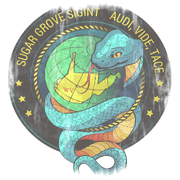
Sugar Grove SigInt
The interior is divided into three distinct sections. The first one entered is the office area, where analysts tried to crack the secrets of the intel provided to them. The main feature is the pile of once-secret documents in the center of the room, surrounded by gas cans and ready for a send-off. The adjacent rooms are mostly empty, save for minor loot, and piled-up furniture. The corridor in the back leads between two derelict conference rooms down below.
At the bottom of the staircase, through low-level robots, lies the security checkpoint and more offices to the side. The offices contain traces of habitation and wrecked office equipment, as well as an intelligence dispenser (used in the quest One of Us). The checkpoint contains hallways covered by a pair of ceiling-mounted turrets. They can be disabled from the booth in the landing area.
Through the checkpoint is the heart of the facility, with broken DEFCON indicators welcoming newcomers to the blacksite. To the right is a hallway leading up to the Sugar Grove director's office, with a terminal and loot. To the left is a hallway that leads to the aforementioned Advanced Research Projects laboratory, filled with rogue robots courtesy of Lockhart's fabricator and the ARP terminal. Down the center lies the SigInt hall.
The SigInt hall contains signals intelligence analysts' terminals (where the player character has to upload MODUS' holotape during One of Us), various holotapes about cryptid sightings, a conference room to the left and the archives chamber - mostly spotless, save for radroaches - to the right. The archives chamber contains a safe at the far end. In the far left corner, on top of the computer and near the safe, is a wooden crate. The opening faces the wall, but it contains the blacksite guard key needed to access the Somnus division.
Somnus Division[]
Accessed from the rear of the facility, the facility requires the Blacksite guard key, located in the Archives wing of the SigInt facility (see above). Once inside, down the flight of stairs lies the Somnus facility, where the Navy processed abducted citizens to turn into sleeper agents. It is shaped like a circle, with the infirmary and processing chamber in the northern half and the cells in the southern. The control center and break room for the staff is to the west.
The cells are locked. Three of the necessary keys are located on the trolley in the break room, while another is on the shelves in the processing room control chamber.
值得注意的物品[]
- 空白全像卡帶 - 進設施後跟著樓梯到達底層,直走經過第一個門左轉,上樓梯到右側的房間。裡面散落很多片全像卡帶。
- 我在盯著你 - 同上,附近桌上。
- 神祕生物目擊記錄:格拉夫頓怪獸9/27 - 在底層監控廳(有大螢幕的區域)第二排其中一個位子桌上。
- 神祕生物目擊記錄:鳥形龍10/4 - 同上。
- 神祕生物目擊記錄:溫迪戈10/25 - 同上。
- 《查爾斯頓先鋒報》獨家報導:主礦脈 - 同上,在最前排左邊的桌上。
- 虹吸專案全像卡帶 - 在底層辦公室區域中分析師的終端機內。
- 禁區警衛鑰匙 - 在設施深處的機房,進去最左前方角落的伺服器上方,鑰匙被翻倒的盒子遮住了。
- 自動來電錄音 - 上述分析師終端機附近地上。
- Around 40 clipboards can be found within Sugar Grove, a good source for springs. A particularly large quantity is found on a shelf in the main room with large screens.
- Many pencils among the desks, including ten lined up on a metal shelf in the DEFCON room of the facility.
- Two random plans:
- On a cabinet behind the armor workbench.
- On the roof, on the staircase to the landing pad, on the second step to the left.
- Six potential Vault-Tec bobbleheads:
- In the green wall cabinet, in the northwest corner of the Advanced Research Laboratory, opposite the collection of blank holotapes, on the upper floor with the window.
- Behind the upturned orange cylindrical cabinet on the desk, inside the small storage room; the last room on the right if heading north at the bottom of the stairs on the lower level.
- On the far metal desk, in the curved corner of the narrow reception and security room, locked with a door (1) and terminal, off the lower lobby, en route to the mission control room.
- On or at the foot of the mainframe computer, in the northeast corner of The Archives.
- On the wooden table, in the green wallpapered cognitive programming room (with the three televisions), in the Secret Facility basement.
- On the wooden crates by the wall, near the two blue barrels, in the southwest corner of the Secret Facility, close to a security door and metal shelving.
- Six potential magazines:
- On the half-buried curio cabinet, left of the Project Director's Terminal, in the upper office with a window overlooking the mission control room, with the Archive Dispenser Vending Machine in the southwest corner.
- On the yellow machinery, inside the security mesh walled area of the Advanced Research Laboratory, near the collection of blank holotapes, on the upper floor with the window.
- On the small round table with the Lunch Pail on it, near the Nuka-Cola machine, on the north stepped side of the Mission Control room.
- Vertical, jammed between two cardboard boxes, in the center of the shelves of boxes at the foot of the huge map screen, in the Mission Control room.
- Below the red wrist rest shelf, at the central mainframe computer in the middle of The Archives.
- Poking out of the small side table shelf, in the green wallpapered cognitive programming room (with the three televisions), in the Secret Facility basement.
禁區[]
- 囚房鑰匙A6-KH、89-AX、B2-RS和V5-XF - 從設施後面的門進入禁區,走下去右轉一直走到有好幾台電視的房間,從旁邊牆上的洞走進去可以找到,有一把在架子上,另外三把放一起。用來打開該區域的牢房,而其中一間牢房的鑰匙在亨特斯維爾。
- Random magazine - At the second interrogation chair room, underneath a small table.
Appearances[]
Sugar Grove appears only in Fallout 76.
幕後[]
舒格格羅夫(Sugar Grove)來自現實的糖林站 ,位於西維吉尼亞州糖林鎮附近的前國安局通訊監聽站,2017年售出,計畫轉型為服務現/退役軍人及軍眷的醫院。
Gallery[]
References[]
- ↑ Sugar Grove terminal entries; Project director's terminal, 6-16-77 Mining Chatter
- ↑ Sugar Grove terminal entries; Project director's terminal, 8-9-77 Mama Dolce's
- ↑ Sugar Grove terminal entries; Project director's terminal, 9-20-77 Grafton Communists
- ↑ Sugar Grove terminal entries; Project director's terminal, 10-13-77 Free States
- ↑ Sugar Grove terminal entries; SigInt system terminal, 9-10-77 Intel Preservation Directive
- ↑ Sugar Grove terminal entries; SigInt system terminal, ARCHIVES: Index
- ↑ Sugar Grove terminal entries; Director's terminal, Somnus Agent EFB825
- ↑ Sugar Grove terminal entries; Director's terminal, Somnus Agent SEL1249
- ↑ Sugar Grove terminal entries; Director's terminal, Somnus Agent AJM1068
- ↑ Sugar Grove terminal entries; Advanced research terminal, BR-04 "LOCUST" - Vertibot Bugging Network
- ↑ Sugar Grove terminal entries; Advanced research terminal, RD-68 BARRIER - Radiation Suppression Field
- ↑ Sugar Grove terminal entries; Advanced research terminal, KM-41 SPOTLIGHT - Neutrino Pulse Emitter
- ↑ Sugar Grove terminal entries; Advanced research terminal, CX-15 SIPHON - Data Exfiltration Program
- ↑ Sugar Grove terminal entries; Analyst's terminal, 9-22-77: SIPHON Holotapes
- ↑ Sugar Grove terminal entries; Advanced research terminal, EX-72 PULSAR - EMP Weapons Development
- ↑ Sugar Grove terminal entries; Advanced research terminal, Research Log: 10/4/77
- ↑ Sugar Grove terminal entries; Advanced research terminal, Research Log: 10/4/77
- ↑ Sugar Grove terminal entries; Advanced research terminal, 10-9-77: Power Use
- ↑ Sugar Grove terminal entries; Advanced research terminal, 10-11-77: Mainframe Storage
- ↑ Sugar Grove terminal entries; Advanced research terminal, 10-11-77: RE: Power Use - URGENT
- ↑ Sugar Grove terminal entries; Analyst's terminal, 10-13-77: Disk Write Errors
- ↑ Sugar Grove terminal entries; Analyst's terminal, 10-18-77: Project PULSAR
- ↑ Sugar Grove terminal entries; Analyst's terminal, 10-21-77: RE: SIPHON Holotape
- ↑ Sugar Grove terminal entries; Advanced research terminal, Research Log: 10/21/77
- ↑ MODUS: "That tape is the first step in our restoration. We would have you take it to an old naval surveillance facility known as Sugar Grove."
(MODUS' dialogue) - ↑ Events of One of Us
| ||||||||||||||||||||||||||||||||||||||

